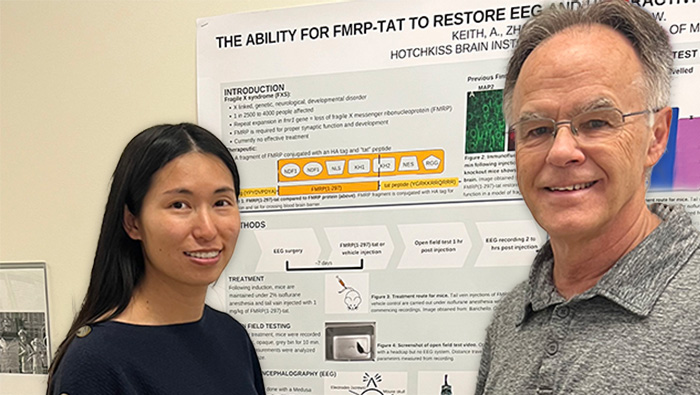A Tat-Conjugate Approach to Treat Fragile X Syndrome

Principal Investigator
FRAXA Postdoctoral Fellow
Calgary, Canada
Summary
Dr. Turner and colleagues are working to treat Fragile X by replacing FMRP, the protein which is lacking in Fragile X syndrome. With a previous grant from FRAXA the team demonstrated that they could inject modified FMRP into the tail vein of mice and see it function in brain cells! They are using a shortened version of FMRP coupled with another short protein called Tat, because this is less toxic and more efficient.
Now they will fine tune the protein to find the version which most effectively reverses signs of Fragile X.
The Science
By Raymond Turner, PhD
The symptoms associated with Fragile X syndrome (FXS) stem from a lack of Fragile X Messenger Ribo-nucleoprotein (FMRP), a protein normally found in virtually all cell types in the brain. We are pursuing a goal of directly reintroducing FMRP or parts of this molecule into the brain to restore function, in a manner akin to insulin treatment of diabetes.
We thus attached a fragment of the FMRP protein (N-terminus) to a cell penetrating “tat” peptide to render the fragment the ability to cross the blood-brain barrier (BBB) and enter the brain. When reintroduced by tail vein injection into a mouse model of FXS, we found that an “FMRP-N-tat” molecule rapidly crossed the BBB and was taken up by key neurons in the cerebellum and neocortex and was retained for at least 48 hours. Work to date has established that FMRP-N-tat shows no apparent toxic effects and acts to restore levels of protein translation, rescues synaptic function important to memory formation, and reduces hyperactivity for up to 24 hours.
While the N-terminal region of the FMRP-N-tat fragment represents 46% of the molecule, it is important to recognize that the rest of the FMRP molecule also contains key functional domains that will need to be reintroduced to fully restore function that is lost in Fragile X syndrome. This project will test the effects of two additional tat-conjugated fragments in the mouse Fmr1 knockout model designed to match FMRP isoform 17, which accounts for 54% of all FMRP expressed in the brain. We will use electroencephalography (EEG) recordings from mice as an established non-invasive biomarker for FXS to test the effects of each of these tat-conjugated fragments alone and when combined with FMRP-N-tat. This FRAXA grant will rapidly advance our goal of testing a complement of FMRP-tat conjugate peptides as a potential therapeutic strategy for FXS.

